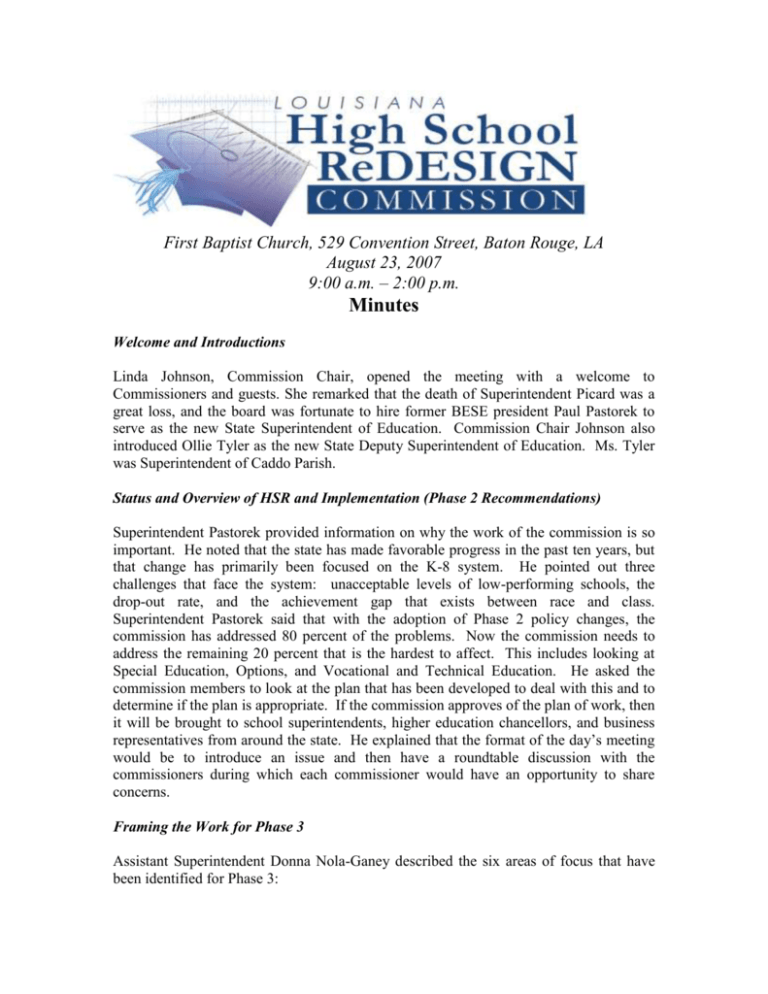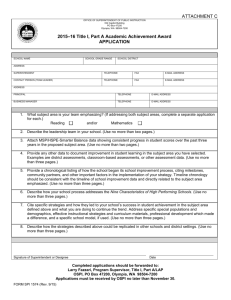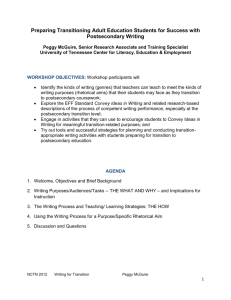Welcome and Introductions - Louisiana Department of Education
advertisement

First Baptist Church, 529 Convention Street, Baton Rouge, LA August 23, 2007 9:00 a.m. – 2:00 p.m. Minutes Welcome and Introductions Linda Johnson, Commission Chair, opened the meeting with a welcome to Commissioners and guests. She remarked that the death of Superintendent Picard was a great loss, and the board was fortunate to hire former BESE president Paul Pastorek to serve as the new State Superintendent of Education. Commission Chair Johnson also introduced Ollie Tyler as the new State Deputy Superintendent of Education. Ms. Tyler was Superintendent of Caddo Parish. Status and Overview of HSR and Implementation (Phase 2 Recommendations) Superintendent Pastorek provided information on why the work of the commission is so important. He noted that the state has made favorable progress in the past ten years, but that change has primarily been focused on the K-8 system. He pointed out three challenges that face the system: unacceptable levels of low-performing schools, the drop-out rate, and the achievement gap that exists between race and class. Superintendent Pastorek said that with the adoption of Phase 2 policy changes, the commission has addressed 80 percent of the problems. Now the commission needs to address the remaining 20 percent that is the hardest to affect. This includes looking at Special Education, Options, and Vocational and Technical Education. He asked the commission members to look at the plan that has been developed to deal with this and to determine if the plan is appropriate. If the commission approves of the plan of work, then it will be brought to school superintendents, higher education chancellors, and business representatives from around the state. He explained that the format of the day’s meeting would be to introduce an issue and then have a roundtable discussion with the commissioners during which each commissioner would have an opportunity to share concerns. Framing the Work for Phase 3 Assistant Superintendent Donna Nola-Ganey described the six areas of focus that have been identified for Phase 3: Setting 10-year Attainment Goals to Communicate to the Public Promoting more Career and Technical Ed Tackling 8th Grade Remediation/Retention/Drop Out Issues Focusing on Guidance and Counseling Considering Alternative Diploma Examining Alternative Education Options She then asked the commission members to focus on three questions: Are the focus areas appropriate? Do you have any that you feel should be added? Is it reasonable to accomplish by June 30? Commission Discussion All commissioners agreed that the focus areas were appropriate. Several felt that the June 30th timeline might be overly ambitious. While no commissioners wanted to add focus areas, many suggestions were made as to issues that should be imbedded within the six focus areas: Expand alternative programs to include students without disabilities Have a method in place to address students who fall through the cracks Develop a consistent evaluation of workplace needs in the state Devise a system for communicating with alternative programs and technical colleges about dropouts. Address the quality of teachers, counselors, and principals Relieve teachers of duties that interfere with quality classroom time Address the low success rate of Options and alternative programs Look at job description, workload, and role of guidance counselors Empower teachers to be agents of change Address economic equality among districts Prevent special education students from being pushed out of the system Address difficulties impoverished rural and urban districts have in developing ties to business Utilize e-Portal Recognize the shortage of math, science, industrial ed teachers, counselors, and administrators Address the challenge of low literacy levels of many students Develop system to address social issues of students Commissioners expressed the following concerns: Funding Hard to achieve by June 30 Could lead to teacher certification issues Accuracy of data communicated to public Establishing Goals Gayle Kirwan, DOE High School Redesign Coordinator, spoke to the group about setting 10-year goals. She explained why it is important to have goals that can be easily communicated to the public. She also pointed out that “postsecondary” and “career” readiness are combined in goal two because the commission wants rigor for all, not a two-track system. The three proposed goals are: 1. Increase Graduation Rate 2. Increase Postsecondary and Career Readiness 3. Increase Participation in Postsecondary Education Tier 1 Committee- Goals (Consensus Suggestions and Rationale) BESE Vice-President Leslie Jacobs reported on the Tier 1 Committee’s proposal for indicators for each goal. She reviewed the indicators and then asked the commissioners to consider whether the goals and indicators are appropriate and what kinds of targets should be set. Indicators for Goal 1 Increase the 4-year graduation rate either from 65%-82% or from 65%-80%. Indicators for Goal 2 80% of graduates will complete LA Core Increase ACT scores from 20.1 to 21.6 Increase number of Career and Technical Endorsements awarded Increase number of dually enrolled/articulated credit in CTE courses Increase number of industry-based certifications awarded Increase number of La Career Readiness Certificates awarded Indicators for Goal 3 Increase percent of public school 11th graders enrolling in Louisiana public postsecondary institutions within four years to 75%. Commission Discussion During the roundtable discussion the commission members made comments and noted concerns about the goals: Goal 2 Increase in ACT score may be too ambitious ACT is not required. Students attending college out of state may take SAT instead Could look at remediation necessary for postsecondary enrollees Consider how dual enrollment/articulation credit affects teachers and facilities Use percents rather than numbers Goal 3 Could look at students attending college out of state Could look at part-time and full-time students General Comments Limited goals will be easier to communicate Angst over infrastructure necessary to accomplish goals Need shorter time frame Need longer time frame Could be challenging to communicate goals to public The commissioners approved the three goals and unanimously agreed that the targets should be “stretch”. The commissioners also unanimously agreed to use the 80% graduation rate as the goal 1 indicator because it will be easier to communicate to the public. CTE for Students who “Opt Out” of LA Core 4 Debi Faucette, Division Director for Family, Career and Technical Education at the DOE presented information about students who opt out of LA Core 4. She noted that Louisiana schools need to prepare a skilled workforce. Students who opt out of Core 4 still need to be prepared for success, and students who do pursue Core 4 should be encouraged to consider technical careers. Debi summarized how four other states are addressing this issue. She then proposed three policy recommendations: 1. Students must complete career area of concentration 2. Students must enroll in and complete Education for Careers course 3. Should require WorkKeys training and assessment Commission Discussion During the commission discussion, consensus was reached that the three policy recommendations are good. Commissioners’ comments are summarized below: Career and technical education goals must align with occupational forecasts Career and Technical Education should be mainstream, not “alternative” or “supplementary” This area needs more discussion Small and rural districts will have capacity and staffing problems Need to promote CTE in academic classes Too big a disconnect between the number prepared for skilled work and the number of workers needed Make courses relevant for LA Core 4 students Do better job educating students as to what is required to succeed after high school Could form partnership with Department of Labor Word documents carefully to avoid liability issues Don’t want to add another layer of stuff- like Options- for schools to have to do Very ambitious but difficult to implement Next Steps Assistant Superintendent Donna Nola-Ganey summarized the meeting - the commission laid out the six focus areas for Phase 3 and raised issues that are imbedded in the six areas, agreed to three broad goals that will go before the public, and agreed on three policy recommendations for Career and Technical Education. The next steps will be to frame up the focus areas, to adjust the indicators as needed, and to work on the specifics of the Career and Technical Ed policy recommendations. A funding package will need to be ready for the Legislature by November. Assistant Superintendent Nola-Ganey reported that the next meeting will be held on Tuesday, September 25. The agenda will include a discussion of issues surrounding 8th grade remediation and retention. Public comments included a clarifying question about students opting out of Core 4 and their need to take a course on careers. Gayle Kirwan answered that many high schools working on ninth grade redesign are adding a career orientation course to their ninth grade curriculum. Students opting out of Core 4 would need to take the course as juniors or seniors only if they did not take it as freshmen. BESE President Linda Johnson thanked everyone for attending. She noted that the meeting was very productive. She urged all participants to share any concerns or additional questions via email. With no further business, the meeting adjourned at 1:45pm. Addendum to Minutes Jerry Pinsel provided the following list of reform measures from Superintendent Pastorek that could take place immediately without a lot of new spending. 1. Add a technical college representative to the Tier 1 discussions. 2. Post the correlations between 8th grade LEAP and EPAS scores (EXPLORE) and share with regional community and technical colleges (recruiting). Add 10th grade PLAN. 3. Realize that if students “opt out’ of the core in 10th grade, they are not eligible for Dual Enrollment money. Early Top Tech only covers courses associated with current list of ICBs and “high demand” occupations. One or the other needs to be changed. 4. LEAs need to provide lists (routinely) of non-returning students (8th to 12th grades) to regional Adult Ed and CC/TCS for aggressive recruiting and recovery into education at another level. 5. All 10th grade plans with IEPs must have a Transition Plan completed with appropriate postsecondary plans and La. Vo-Rehab money. 6. Create Regional Youth Recovery Councils per region: LEAs, CCS/TCS/Adult Ed, DSS/OCS, OYD, local law enforcement, etc. 7. Reduce the 60 graduate hour Masters in Counseling to the normal 30 hour Masters to increase pool of counselors. Thought: Focus Area #3 (8th Grade Remediation) Add: Number or percent of 9th-10th graders enrolled in postsecondary ed (as a recovery/retention measure). Active coenrollments: ABE/GED and postsecondary education.







